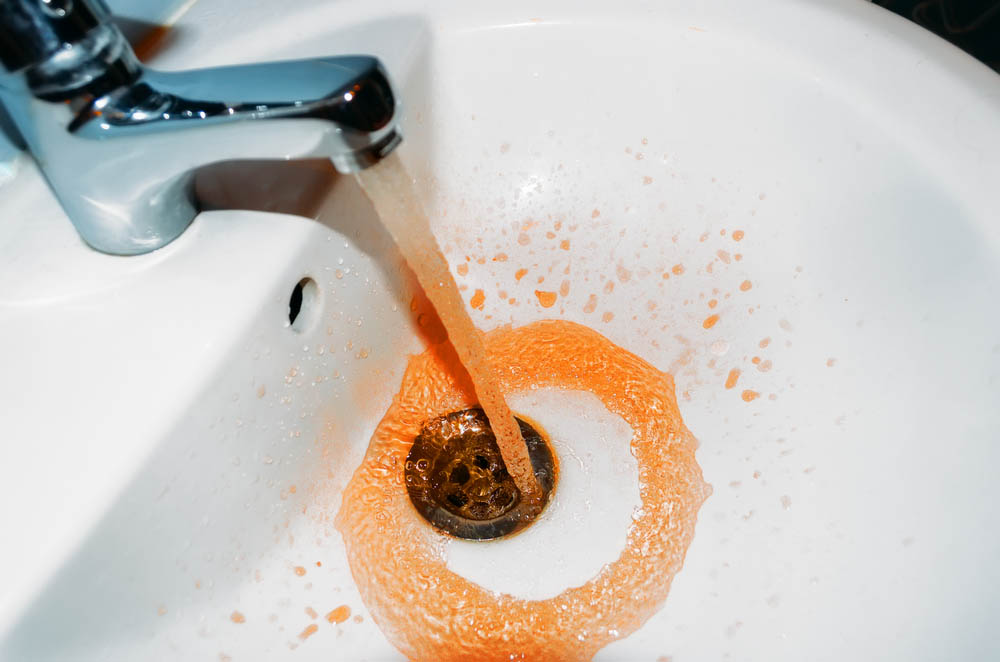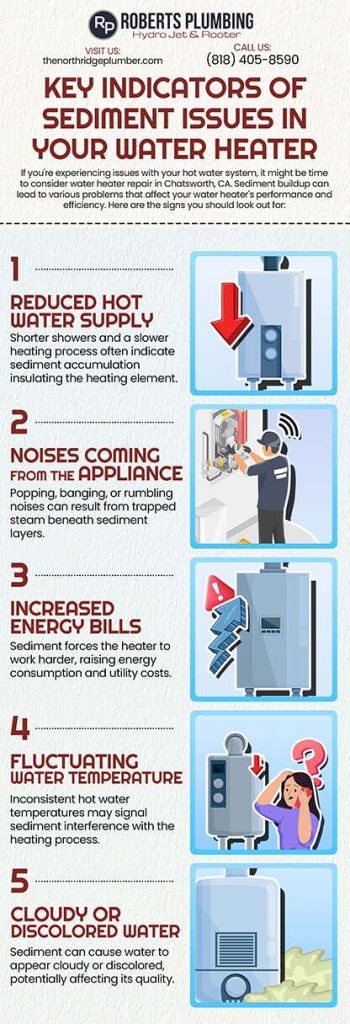Indications of Sediment Buildup in Your Water Heater

A well-functioning water heater is an indispensable part of any home, ensuring hot water is readily available for showers, washing dishes, and laundry. Over time, however, sediment can accumulate in your water heater, leading to various issues. Recognizing the signs of sediment buildup can help you address problems before they become severe and maintain the efficiency of your appliance.
As the trusted local team for expert water heater repair in Chatsworth, CA, Roberts Plumbing Hydro Jet & Rooter discusses some indications of sediment buildup in your water heater and why it should not be ignored.

Reduced Hot Water Supply
One of the most noticeable signs of sediment buildup in your water heater is a decrease in the hot water supply. You might find yourself taking shorter showers or repeatedly waiting for the water to heat up during chores. This is frustrating, especially when you have plenty of things to do. The sediment layer at the bottom of the tank can insulate the water from the heating element, preventing it from effectively heating up. It’s as if there’s a blanket in between your water and the heat source.
If you’re running out of hot water faster than usual, something is clearly off. You may think it’s just a sign of needing a hot water heater replacement, but before going that route, it’s worth checking for sediment buildup first.
Flushing the tank periodically can prevent sediment buildup and maximize your water heater’s efficiency. If you’re unsure about how to do this yourself, our experienced technicians at Roberts Plumbing Hydro Jet & Rooter can offer guidance or handle the job for you. This way, you can ensure your water heater is always running at its best.
Noises Coming from the Appliance
Many homeowners report hearing popping, banging, or rumbling sounds emanating from their water heaters. These noises can often be caused by the sediment that collects at the bottom of the tank. As the heating element warms the water, the sediment can trap small amounts of water beneath it. When this trapped water turns into steam, it creates pressure and causes the popping sounds as it tries to escape.
It’s easy to dismiss these noises and assume they’ll disappear on their own. But take it from us — this is a mistake you don’t want to make. The longer you leave the sediment in your water heater, the more it will build up and cause further damage. Eventually, it can even lead to cracks or leaks in the tank.
At the first sign of strange sounds coming from your water heater, it’s best to have professional water heater services take a look. They can confirm whether or not sediment buildup is the culprit and provide the necessary solutions to prevent further issues.
Increased Energy Bills
As mentioned earlier, sediment buildup creates an insulating barrier between the heating element and the water. This means your water heater must work harder and longer to achieve the desired temperature, which leads to increased energy consumption.
If you notice a significant spike in your utility bill without any changes to your usage habits, a malfunctioning water heater could be to blame. Addressing sediment buildup promptly can help restore efficiency, reduce energy costs, and extend the lifespan of your appliance.
To keep your water heater running smoothly and minimize energy waste, it’s essential to schedule regular maintenance appointments with a trusted plumbing service. They can inspect and flush the unit, as well as check for any other issues that may be affecting its performance.
Fluctuating Water Temperature
You might notice that the hot water is not as hot as it used to be or that it fluctuates between hot and cold unexpectedly. Sediment buildup can interfere with the heating process, leading to these temperature inconsistencies. Imagine how frustrating it can be when you’re in the middle of a relaxing shower and suddenly get hit with cold water.
If you’re curious, sediment buildup can also occur in a tankless water heater. The mineral deposits can collect in the heat exchanger, causing the same issues with efficiency and temperature control. Contrary to popular belief, flushing is not just for traditional tank water heaters — it’s also recommended for modern tankless models.
Cloudy or Discolored Water
Is cloudy or discolored water coming from your hot water tap? This can be particularly alarming, as clean, clear water is a basic expectation in our homes. When sediment accumulates in your water heater, it can lead to the presence of particles and minerals that cloud the water or alter its color. This manifestation is not just a cosmetic issue; it can indicate deeper problems that might affect the quality and safety of your drinking water.
No one wants to use or consume water that doesn’t look or smell right. If you notice any changes in your hot water’s appearance, it’s crucial to schedule a professional inspection to identify the cause and gain back your peace of mind.
Roberts Plumbing Hydro Jet & Rooter is always ready to help with any concerns or issues with your water heater. From water heater installation and repair to maintenance, our experienced team can keep your appliance in top shape for optimal efficiency and performance.
We are licensed, bonded, and insured, and we have been in business for 25 years, so you can trust us to provide high-quality service and lasting solutions. Contact us today or fill out our online form to request a service visit.




